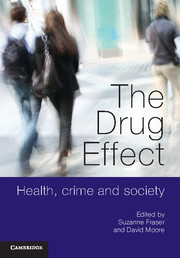Book contents
- Frontmatter
- Contents
- List of contributors
- Acknowledgements
- Introduction
- Part 1 Drug use as social and cultural practice
- 1 The social life of smokes
- 2 Party animals
- 3 Pleasure and pain
- 4 The ontological politics of knowledge production
- Part 2 Drugs, health and the medicalisation of addiction
- Part 3 Drugs, crime and the law
- Index
- References
3 - Pleasure and pain
Representations of illegal drug consumption, addiction and trafficking in music, film and video
from Part 1 - Drug use as social and cultural practice
- Frontmatter
- Contents
- List of contributors
- Acknowledgements
- Introduction
- Part 1 Drug use as social and cultural practice
- 1 The social life of smokes
- 2 Party animals
- 3 Pleasure and pain
- 4 The ontological politics of knowledge production
- Part 2 Drugs, health and the medicalisation of addiction
- Part 3 Drugs, crime and the law
- Index
- References
Summary
Since the criminalisation of a number of drugs in Western nations, popular culture has become saturated with drug references, iconic imagery and symbolism. In fact, drug prohibition appears to have spurred a proliferation of racialised, gendered and class-biased drug imagery in film and musical lyrics about forbidden, outlawed and officially condemned practices. Through visual imagery, narrative and music, films communicate meaning about drugs and the people who take them. These both reflect and produce understandings of illicit drugs, playing a part in public perceptions of drug use and in policy and other responses to perceived drug crises. Drawing on critical and feminist criminology, sociology and cultural studies, this chapter analyses the representation of illicit drug use in popular culture, focusing on music in drug films and music videos. These texts illuminate the diversity and complexity of representations of drug consumption, addiction and trafficking, in popular culture. They point to our ambivalence about drugs, intoxication, consumption and pleasure. Using qualitative research methods I explore the narrative themes of drug trafficking, drug consumption and addiction that emerge in a sample of texts produced between 1960 and 2010. Rather than viewing music, film and music video as ‘mere entertainment’, I understand them to be cultural agents that produce and reproduce ‘systems of meaning’ about drugs, pleasure, drug users, addiction, degradation, crime, treatment, punishment and redemption. In turn, I argue, these meanings both give impetus to conventional punitive responses to drug use and create new spaces in which to build alternative responses.
Background
Drug use has appeared in popular film and other entertainment from its earliest days. A number of films made in the 1920s and 1930s represent drugs such as marijuana, cocaine and opiates as pleasurable, mainstream and compatible with non-criminal lifestyles. Similarly, a number of positive drug songs such as ‘Reefer Man’, depicted in the 1930s Hollywood comedy, International House (1933), and Ella Fitzgerald's 1938 song about cocaine, ‘Wacky Dust’, were popular. Following drug prohibition, positive film representations of criminalised drugs were eventually banned in the USA and elsewhere. In contrast, prohibitionist films such as Narcotic (1923) and Reefer Madness (1935) entertained and educated moviegoers about the horrors of drugs and addiction. These propagandist anti-drug narratives depict the supposed degradation associated with opium/heroin and marijuana addiction and jazz music, portray violent dealers threatening white moral society, and call for more policing and laws.
- Type
- Chapter
- Information
- The Drug EffectHealth, Crime and Society, pp. 57 - 72Publisher: Cambridge University PressPrint publication year: 2011



